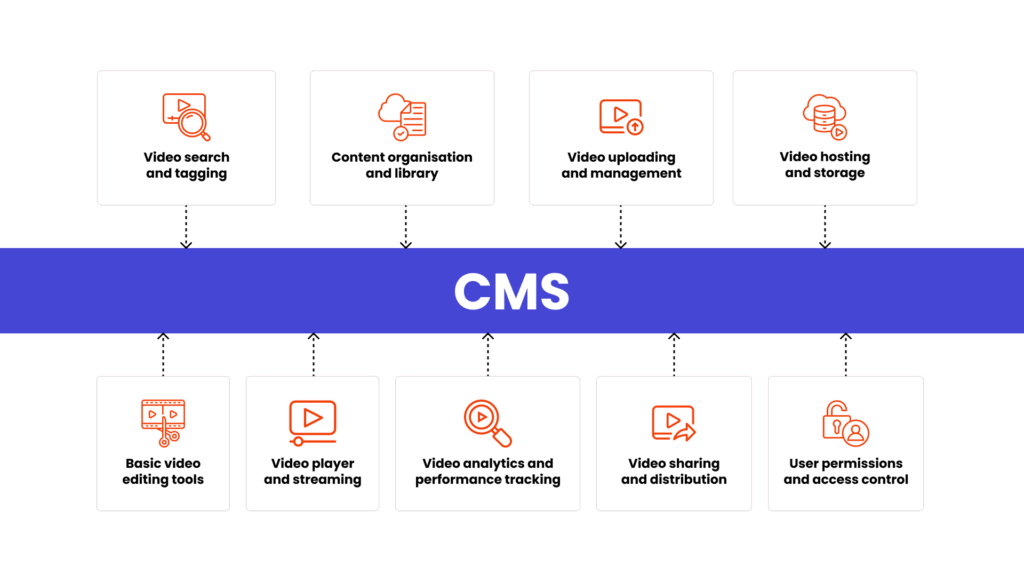Mastering Video CMS: tips for better Video Content Management
Your marketing team needs that product demonstration video for tomorrow’s campaign launch, but it’s buried somewhere across multiple cloud drives and shared folders. Meanwhile, your training department recreates content that already exists, and your IT team struggles with large video files that crash traditional storage systems. Sound familiar?
So, the question is: how do you effectively manage video assets at scale without drowning in chaos? This is where video content management systems come in. They transform scattered, inefficient video workflows into streamlined operations that enhance your video strategy and deliver measurable results.
In this guide, we’ll explore the essential features and benefits of a video content management platform. And if you decide to implement one, you’ll also get practical tips on what to consider when choosing the right video CMS for your organisation.
What is a video CMS?
A video Content Management System (Video CMS) is a specialised platform designed to store, organise, manage, and distribute video content from a centralised location. Unlike traditional content management systems that struggle with large video files, a dedicated video CMS is purpose-built to handle the unique challenges of managing video assets – from complex formats and video transcoding to multi-platform distribution and detailed video analytics.
Enterprise video CMS solutions take this further by offering advanced security features, integration with customer relationship management systems, and sophisticated workflow management for large teams managing extensive video libraries.
Whether you’re running marketing campaigns, hosting virtual events, delivering video-on-demand content, or managing internal training materials, the right video CMS transforms chaotic video management into a streamlined, efficient process that enhances your video strategy.
Benefits of a video CMS
Centralised content control
A video content management platform eliminates the chaos of scattered video files across different storage solutions. Your entire video library becomes accessible from a single central repository, dramatically reducing time spent searching for content and ensuring video assets remain organised and discoverable.
Enhanced video performance
Video CMS platforms optimise content delivery through automatic video transcoding into multiple formats and resolutions. Adaptive bitrate streaming ensures smooth playback across mobile devices and varying network conditions, while reducing buffering issues that frustrate viewers and hurt engagement.
Enterprise-grade security
Unlike public platforms, a dedicated video CMS provides robust security features including access controls, encryption, and user permission management. Organisations can protect sensitive training materials, internal communications, and proprietary content while maintaining compliance with industry regulations.
Data-driven optimisation
Comprehensive video analytics reveal detailed insights about viewer behaviour, engagement patterns, and content performance. Video heatmaps and completion rate tracking enable you to refine your video marketing strategy based on actual user data rather than assumptions.
Streamlined workflows
Video CMS software eliminates workflow bottlenecks through version control, team collaboration tools, and automated publishing across multiple channels. Teams can review, approve, and distribute video content efficiently without manual coordination overhead.
Scalable infrastructure
As your video content library grows, enterprise video CMS solutions automatically scale storage, bandwidth, and processing capabilities. The platform adapts to increased demand without requiring infrastructure investments or technical migrations.
Revenue generation opportunities
Advanced platforms offer monetisation tools including subscription management, pay-per-view options, and advertising integration. Transform your video assets from cost centres into revenue-generating resources.
Don’t let disorganised video content slow you down
Learn moreKey features of a video CMS

Understanding the essential features of a video content management system is crucial for anyone looking to manage video content effectively and maximise their video strategy. Modern video CMS platforms offer sophisticated capabilities that transform how organisations handle their video assets.
Here are the key features to look for in a video CMS:
Video hosting and storage
The platform provides secure, scalable video hosting with cloud-based storage that efficiently handles large video files. It should offer reliable infrastructure for storing and serving your video content globally with guaranteed uptime and fast access speeds.
Video uploading and management
Streamlined upload capabilities support multiple file formats with bulk upload options for existing videos. The system handles video files of various sizes and automatically processes them for optimal storage and playback.
Content organisation and library
A comprehensive video library management system offers folder structures, categories, and collections for efficient content organisation. The platform enables organising video content through hierarchical systems that keep your digital assets systematically arranged and easily accessible.
Video search and tagging
Advanced search functionality combines video tags, metadata filtering, and keyword search capabilities to help users locate content quickly. The system allows users to find specific video files within large libraries through both automated and manual tagging systems.
Basic video editing tools
Built-in video editing capabilities include trimming, cropping, thumbnail generation, and caption addition for essential content modifications. These editing functions eliminate the need for separate software when making basic changes to your video content.
Video player and streaming
The platform provides reliable video streaming with a customisable interactive video player that adapts to different devices and screen sizes. Adaptive bitrate streaming technology ensures optimal video quality across mobile devices and varying network conditions.
User permissions and access control
Comprehensive security features include user roles, access permissions, and content restrictions that control who can interact with your content. The system allows you to manage who can view, edit, upload, or share videos within your organisation.
Video sharing and distribution
Easy video sharing capabilities enable embedding videos across websites, social media, and multiple channels with simple sharing options. The platform generates shareable links and embeds codes for seamless content distribution across different platforms.
Video analytics and performance tracking
Essential video analytics track viewer engagement, play counts, completion rates, and basic video performance metrics that inform content strategy. These data insights help optimise your video marketing efforts and measure content effectiveness.
How to choose the right video CMS?
Now that you understand the essential features, selecting the best video CMS for your organisation requires evaluating how well each platform aligns with your specific needs and technical requirements.
- Prioritise user experience: The right video CMS should enable your entire team to manage video content efficiently, regardless of technical expertise. Look for intuitive interfaces with drag-and-drop uploading that allow non-technical members to create video content without extensive training.
- Evaluate integration capabilities: Your video content management platform must connect seamlessly with your existing technology stack. Prioritise solutions offering robust API integration and native compatibility with your customer relationship management system and marketing tools.
- Assess security requirements: Enterprise organisations require video CMS software with comprehensive security features, including access controls, encryption, and audit trails. Evaluate whether the platform meets your compliance requirements and protects sensitive video assets.
- Consider collaboration features: Effective platforms streamline team collaboration through version control, user role management, and approval workflows. These features become critical when multiple stakeholders need to review and approve video content before publication.
- Analyse performance tracking: The platform should provide detailed video analytics that track viewer engagement and performance metrics. These insights help optimise your video strategy and demonstrate ROI on your video marketing investments.
- Plan for future scalability: Choose video CMS platforms that accommodate growth through enhanced storage capacity, advanced CDN support, and expanding user management needs. Scalable infrastructure prevents costly platform migrations as your video library and audience expand.
- Test content discovery features: Evaluate how effectively you can locate specific video files within large libraries. Look for platforms offering AI-powered automated video tags, comprehensive metadata systems, and flexible search capabilities that improve content organisation efficiency.
- Consider global accessibility requirements: Ensure your platform supports accessibility standards, including automatic subtitle generation, multilingual captioning, and screen reader compatibility. These features expand audience reach while ensuring compliance with accessibility regulations.
- Evaluate advanced workflow capabilities: Look for platforms offering batch transfer capabilities for migrating existing content, automated playlist generation for video on demand programming, and AI-powered tools for content transcription and object recognition that reduce manual cataloguing tasks.
- Assess multi-format support and delivery: Verify the platform handles video transcoding across multiple formats and resolutions automatically. Adaptive bitrate streaming capabilities ensure optimal playback quality across mobile devices and varying network conditions without manual intervention.
- Review monetisation and revenue features: If revenue generation is important, evaluate built-in monetisation tools, including subscription management, pay-per-view options, advertising integration, and live streaming capabilities that can transform video assets into profit centres.
- Examine technical architecture and performance: Test the platform’s ability to handle large video files, concurrent users, and peak traffic scenarios. Assess video delivery speed, processing times for uploads, and overall system responsiveness during realistic usage conditions.
- Conduct real-world testing: Before committing to any video CMS provider, test the platform under realistic conditions, including high-traffic scenarios, various device types, and your actual content workflows. This reveals potential bottlenecks and validates whether the solution meets operational demands.
Ready to transform your video management strategy?
Implementing a successful video content management solution requires careful planning, technical expertise, and ongoing optimisation. The right video CMS doesn’t just solve today’s chaos – it transforms your entire approach to video assets, turning scattered workflows into strategic advantages that drive measurable business results.
At Spyrosoft BSG, we’ve helped media companies transform their video content management infrastructure through proven implementations and strategic guidance. Our comprehensive approach combines deep technical expertise with industry knowledge to deliver solutions that enhance your video marketing effectiveness and operational efficiency.
Whether you’re looking to implement your first video CMS, upgrade existing systems, or optimise your current video management workflows, our team can guide you through every aspect of the process.
Check our offer to learn how we can help you create a competitive advantage through video content management.
About the author
Contact us





![[thumbnail] media and entertainment - android tv guide](https://spyro-soft.com/wp-content/uploads/2025/06/thumbnail-media-and-entertainment-android-tv-guide-1024x655.png)